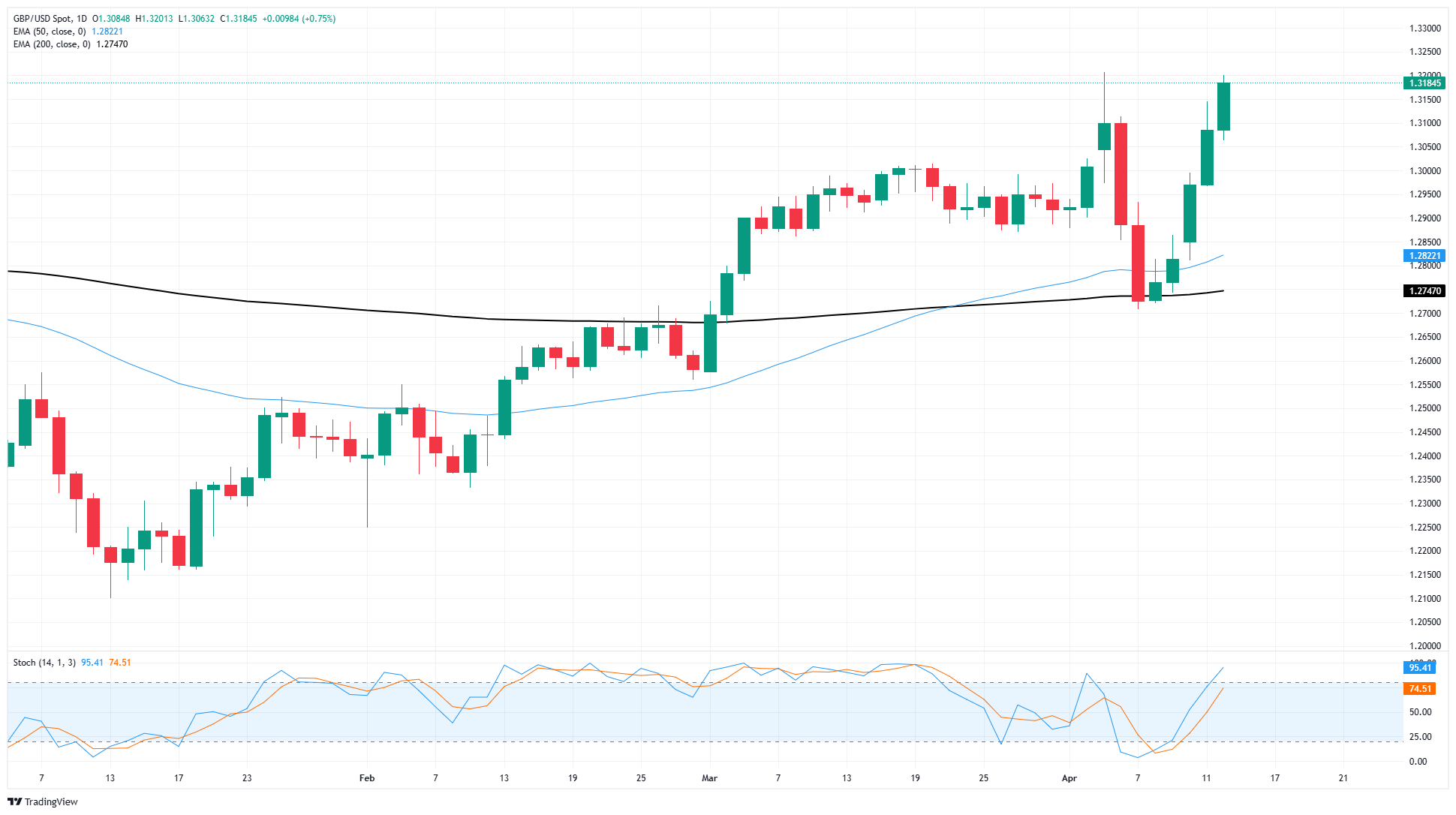- GBP/USD rose another 0.75% on Monday, climbing for a week straight.
- The Sterling’s broad recovery against the Greenback is poised to run up against key UK data this week.
- UK labor figures are due on Tuesday, followed by UK CPI inflation data on Wednesday.
GBP/USD rose three-quarters of one percent on Monday, climbing for a fifth straight trading session as the Pound Sterling continues to reclaim ground against the softening Greenback. Despite the GBP’s firm run up the charts against the USD, challenges still lie ahead with key UK economic data on the release docket for this week.
UK labor data will be posted early during the Tuesday London market session. The ILO Unemployment Rate for the 3 months ended in February is expected to hold steady at 4.4%, and the Claimant Count Change for March is forecast to ease to 30.3K from February’s 44.2K.
UK Consumer Price Index (CPI) inflation figures will be posted on Wednesday. Headline UK CPI inflation is forecast to tick down to 2.7% YoY from the previous period’s 2.8%, while core CPI inflation is expected to remain stubbornly pinned at 3.5% YoY.
GBP/USD price forecast
GBP/USD is testing multi-month highs near the 1.3200 handle after rising for a week straight. Cable has risen 3.88% bottom-to-top after the last swing low into the 200-day Exponential Moving Average (EMA) near 1.2700.
GBP/USD daily chart

Pound Sterling FAQs
The Pound Sterling (GBP) is the oldest currency in the world (886 AD) and the official currency of the United Kingdom. It is the fourth most traded unit for foreign exchange (FX) in the world, accounting for 12% of all transactions, averaging $630 billion a day, according to 2022 data. Its key trading pairs are GBP/USD, also known as ‘Cable’, which accounts for 11% of FX, GBP/JPY, or the ‘Dragon’ as it is known by traders (3%), and EUR/GBP (2%). The Pound Sterling is issued by the Bank of England (BoE).
The single most important factor influencing the value of the Pound Sterling is monetary policy decided by the Bank of England. The BoE bases its decisions on whether it has achieved its primary goal of “price stability” – a steady inflation rate of around 2%. Its primary tool for achieving this is the adjustment of interest rates. When inflation is too high, the BoE will try to rein it in by raising interest rates, making it more expensive for people and businesses to access credit. This is generally positive for GBP, as higher interest rates make the UK a more attractive place for global investors to park their money. When inflation falls too low it is a sign economic growth is slowing. In this scenario, the BoE will consider lowering interest rates to cheapen credit so businesses will borrow more to invest in growth-generating projects.
Data releases gauge the health of the economy and can impact the value of the Pound Sterling. Indicators such as GDP, Manufacturing and Services PMIs, and employment can all influence the direction of the GBP. A strong economy is good for Sterling. Not only does it attract more foreign investment but it may encourage the BoE to put up interest rates, which will directly strengthen GBP. Otherwise, if economic data is weak, the Pound Sterling is likely to fall.
Another significant data release for the Pound Sterling is the Trade Balance. This indicator measures the difference between what a country earns from its exports and what it spends on imports over a given period. If a country produces highly sought-after exports, its currency will benefit purely from the extra demand created from foreign buyers seeking to purchase these goods. Therefore, a positive net Trade Balance strengthens a currency and vice versa for a negative balance.
Information on these pages contains forward-looking statements that involve risks and uncertainties. Markets and instruments profiled on this page are for informational purposes only and should not in any way come across as a recommendation to buy or sell in these assets. You should do your own thorough research before making any investment decisions. FXStreet does not in any way guarantee that this information is free from mistakes, errors, or material misstatements. It also does not guarantee that this information is of a timely nature. Investing in Open Markets involves a great deal of risk, including the loss of all or a portion of your investment, as well as emotional distress. All risks, losses and costs associated with investing, including total loss of principal, are your responsibility. The views and opinions expressed in this article are those of the authors and do not necessarily reflect the official policy or position of FXStreet nor its advertisers. The author will not be held responsible for information that is found at the end of links posted on this page.
If not otherwise explicitly mentioned in the body of the article, at the time of writing, the author has no position in any stock mentioned in this article and no business relationship with any company mentioned. The author has not received compensation for writing this article, other than from FXStreet.
FXStreet and the author do not provide personalized recommendations. The author makes no representations as to the accuracy, completeness, or suitability of this information. FXStreet and the author will not be liable for any errors, omissions or any losses, injuries or damages arising from this information and its display or use. Errors and omissions excepted.
The author and FXStreet are not registered investment advisors and nothing in this article is intended to be investment advice.
Recommended content
Editors’ Picks

AUD/USD: Momentum favours further gains
In line with the broad recovery in the risk-linked complex, AUD/USD left behind a two-day negative streak and resumed its uptrend towards the 0.6400 region, always on the back of the resurgence of quite a strong downside pressure hitting the US Dollar on Thursday.

EUR/USD: Extra advances appear in the pipeline
EUR/USD followed the widespread improved sentiment in the risk-linked galaxy and managed to set aside two daily drops in a row and refocus on the upper end of its recent range around the 1.1400 zone on Thursday.

Gold price climbs past $3,300 on uncertainty about trade and weak USD
Gold snaps two-day losing streak, gaining 1.5% on fresh trade war fears. Trump softens tariff talk, but China denies negotiations and demands full rollback. Fed rate cut bets rise as yields drop and economic uncertainty builds.

Ondo Finance hits $3B market cap as CEO Nathan Allman meets SEC to discuss tokenized US securities
Ondo Finance met with officials of the SEC and the law firm Davis Polk to discuss the regulation of tokenized US securities. Topics included registration requirements, broker-dealer rules and proposed compliant models for tokenized securities issuance.

Five fundamentals for the week: Traders confront the trade war, important surveys, key Fed speech Premium
Will the US strike a trade deal with Japan? That would be positive progress. However, recent developments are not that positive, and there's only one certainty: headlines will dominate markets. Fresh US economic data is also of interest.

The Best brokers to trade EUR/USD
SPONSORED Discover the top brokers for trading EUR/USD in 2025. Our list features brokers with competitive spreads, fast execution, and powerful platforms. Whether you're a beginner or an expert, find the right partner to navigate the dynamic Forex market.


